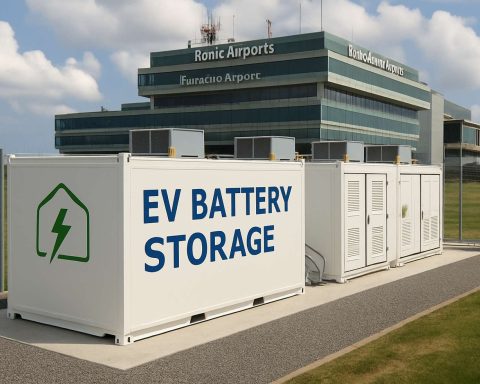- Autonomous vehicles, powered by AI and advanced computing, are expanding rapidly across global cities, led by WeRide’s robotaxi fleet and alliances with major mobility platforms like Uber.
- Quantum computing partnerships, such as IonQ and Einride, promise disruptive efficiency and sustainability for global logistics by solving complex fleet optimization challenges.
- Atlanta stands as a key testing hub, hosting Zoox and Waymo’s autonomous fleets, providing real-world trials in dynamic urban conditions.
- Retrofitting older buses with smart safety technology is making public transit safer and more efficient, especially for cost-conscious agencies.
- Cybersecurity and regulatory compliance are essential, with companies like TIER IV enhancing protections for autonomous vehicles.
- Simulation platforms accelerate AI training using synthetic driving scenarios, streamlining development and ensuring safety.
- Public skepticism and regulatory uncertainty persist, highlighting the need for transparent safeguards and collaboration.
- Open data initiatives and industry cooperation are fostering standardization, shared progress, and greater trust in autonomous transportation.
The world’s roads are humming with a new kind of energy—one driven not by gasoline or human hands, but by the relentless advance of artificial intelligence, quantum computing, and a fierce global race for technological dominance. The promise of driverless vehicles, once the terrain of science fiction, is materializing in striking ways, stitching together continents with silicon, data, and ambition.
WeRide’s Global Surge Ushers In a Robotaxi Renaissance
Glinting under the spotlights of international markets, WeRide has shifted gears in the race to full autonomy. The company, now operating a fleet of over 1,200 autonomous vehicles, has unleashed 24-hour ride-hailing services in Guangzhou and is piloting robobuses and robovans in China, Singapore, and France. This surge paves roads for a future where catching a robotaxi is as routine as hailing a cab. The deepened alliance with Uber, bringing robotaxi networks to 15 new cities and garnering a $100 million investment, signals that major mobility platforms are betting big on AI-driven fleets. In the Middle East, Dubai’s forthcoming launch hints at a world map that will soon be stippled with autonomous outposts.
Quantum Computing: Logistics’ Secret Weapon
While the vehicles attract the spotlight, the logistics powering their movement are getting supercharged too. IonQ and Einride are joining forces to wield the power of quantum computing—technology so advanced it’s measured against the theoretical limits of physics rather than traditional IT. Their collaboration sets its sights on the knotted challenges of global freight: optimizing routes and managing fleets so vast and unpredictable that standard computers simply can’t keep up. With innovation centers in Sweden and Switzerland, this partnership underscores quantum computing’s creep out of the laboratory and onto the highways, promising sustainability and efficiency gains in an industry ripe for disruption.
Atlanta: Testbed of the Driverless Dream
Atlanta is emerging as a crucible for this new era. Amazon’s Zoox now prowls its streets—albeit with vigilant human operators in the driver’s seat—as it takes on the city’s notorious thunderstorms and traffic snarls to push autonomous capabilities to their limits. Not to be outdone, Uber has tapped Waymo’s glittering fleet of electric Jaguars for early-access driverless rides covering some of Atlanta’s most dynamic neighborhoods. For daring riders, a few taps in the app open the door to a hands-free, pedal-free commute.
Retrofitting the Future: Smart Upgrades for Old Buses
Not every innovation involves shiny new vehicles. In Ohio, Perrone Robotics and the NEORide transit consortium are quietly rewriting the rules by retrofitting existing buses with advanced safety systems like collision avoidance and adaptive cruise control. Backed by a USDOT grant, this project exemplifies pragmatic progress: boosting safety and efficiency for budget-conscious transit agencies, and transforming yesterday’s fleets into tomorrow’s guardians.
Securing Autonomy: Cyber Defenses Rise Up
With so much at stake, the digital skeletons of these vehicles demand ironclad protection. Japanese startup TIER IV, working alongside cybersecurity expert PlaxidityX, is fortifying autonomous minibuses to comply with the world’s strictest security standards. Their partnership not only satisfies the stringent demands of regulatory bodies, but also signals a new baseline for trust in the swirling data clouds guiding tomorrow’s vehicles.
Simulation: The New Proving Ground
Behind the wheel or behind the screen, proving safe autonomy requires an astonishing volume of testing. Foretellix’s Foretify platform now transmutes mountains of real driving data into dazzlingly realistic synthetic scenarios, allowing for faster, safer, and more affordable AI training. With industry giants—from Toyota to Volvo—on board, the technology is poised to slash development timelines and democratize access to self-driving innovation.
Society’s Cautious Embrace
But as technology sprints ahead, society grapples with fear and skepticism. The recent reinstatement of human drivers in Texas’ autonomous trucks—after a bold push for fully driverless long-haul trips—highlights the public’s anxiety and the regulatory vacuum at the national level. Experts are urgently calling for comprehensive safeguards, wary that unchecked experimentation could turn highways into corridors of risk.
Open Data and Collaboration Light the Way
Hope, however, springs from cooperation. MAN Truck & Bus’s decision to release a treasure trove of real-world trucking data—747 painstakingly cataloged scenes from German roads—not only fuels the collective wisdom of the industry but also lays foundational stones for standardization and safety. Their accolade as ‘Engineering Team of the Year’ underscores a truth: in this race, collaboration, not competition, just might win.
The Takeaway: Acceleration With Caution
The autonomous vehicle era is no longer confined to the drawing board. Advanced software, quantum horsepower, and cross-industry alliances are shattering yesterday’s limitations. Yet, for every bold experiment, there must be safeguards—a harmony of innovation, transparency, and responsibility. The future of the world’s highways will be written not just by algorithms, but by the trust and oversight society demands. As these machines become our chauffeurs, what remains vital is the assurance that their revolution serves us all.
For more on transportation and technological innovation, visit The New York Times or BBC News for comprehensive coverage.
The Surprising Truths Behind the AI-Powered Race for Autonomous Vehicles
Introduction
The world is hurtling toward an era where artificial intelligence, quantum computing, and global alliances are transforming the very concept of transportation. But beyond the headline-grabbing launches, what deeper facts, hidden trends, and practical realities shape this future? Let’s unpack the key developments, industry trends, real-world implications, feature breakdowns, and actionable insights around the rise of autonomous vehicles and the next-generation mobility ecosystem.
—
WeRide and the Global Robotaxi Boom: Beyond the Hype
WeRide, a key player in autonomous mobility, has made headlines by expanding robotaxi and robobus deployments across China, Singapore, and France. However, there’s more to their approach than aggressive scaling:
Additional Facts & Industry Insights
– Patent Portfolio Power: WeRide reportedly holds over 400 patents related to autonomous driving, many focused on urban scenarios and complex weather, bolstering its technical leadership. [Source: WeRide Press Releases]
– HD Mapping Expertise: The company has invested heavily in building centimeter-level HD maps using in-house Lidar data, essential for safe, precise navigation.
– Localization Partnerships: Beyond Uber, WeRide has entered partnerships with local taxi operators and transit authorities, smoothing regulatory hurdles and building trust.
– Market Forecast: Allied Market Research projects the global robotaxi market will exceed $38 billion by 2030, with APAC leading growth.
How-To: Ride a Robotaxi
1. Download the Relevant App: (e.g., Uber, local AV service)
2. Verify Service Area: Confirm autonomous rides are offered at your location.
3. Enable Real-Time Navigation: Share your location and destination for optimal route selection.
4. Follow Safety Instructions: Use seat belts and pay attention to any briefing or in-app prompts.
Pros & Cons
| Pros | Cons |
|——————-|————————–|
| Lower fares | Limited routes/coverage |
| 24/7 availability | Public trust barriers |
| Lower emissions | Job displacement risks |
—
Quantum Computing in Logistics: What You Haven’t Heard
Unexplored Facts
– What is Quantum Advantage? Quantum computers like IonQ’s use qubits that exist in multiple states, allowing parallel processing of vast logistical problems that stump even supercomputers.
– Real-World Projects: Einride is piloting quantum-optimized route planning for electric truck fleets in Sweden, showing up to 15% fuel savings in simulations.
– Eco Impact: Optimizing “deadhead miles” (empty truck runs) with quantum routing could reduce annual CO₂ emissions from freight transport by millions of tons.
– Investment Surge: According to McKinsey, investments in quantum logistics startups have tripled since 2021, signaling high industry confidence.
Tutorial: Simulate Your Own Logistics Optimization
1. Access basic quantum simulation tools (e.g., IBM Q Experience)
2. Input sample delivery scenarios
3. Compare quantum vs. classical routing results
4. Observe computational speed and route quality
—
Retrofitting Buses: Hidden Sustainability Wins
Additional Facts
– Cost Savings: Retrofitting legacy buses costs 60-80% less than buying new autonomous models—an attractive option for cash-strapped cities.
– Upgraded Safety: Adoption of AI-powered driver assist (ADAS) systems has been linked, per NHTSA, to a 30% reduction in rear-end collisions in urban transit buses.
– Grant Opportunities: U.S. DOT and state agencies now offer dedicated retrofit grants to accelerate fleet modernization.
—
Cybersecurity: Core Features & Challenges
Further Insights
– Global Standards: Initiatives like ISO/SAE 21434 (“Road Vehicles — Cybersecurity”) now guide AV system development worldwide.
– Notable Breaches: 2022 saw several “white hat” hacks demonstrate AV systems’ vulnerability to GPS spoofing and sensor jamming—prompting rapid security upgrades.
– Encryption Trends: Vehicle-to-Everything (V2X) communications now regularly employ end-to-end encryption using protocols like TLS 1.3.
– Continuous Monitoring: Leading fleets leverage cloud-based threat analytics for real-time intrusion detection.
—
Simulation: Scaling Safety and Trust
Industry Facts & Trends
– Data Volume: Training a robust robotaxi AI typically requires simulation of 10+ billion virtual miles—practically impossible to achieve on real roads within a reasonable timeframe.
– Synthetic Data: Companies like Foretellix provide synthetic datasets that balance rare event simulation (e.g., jaywalking, debris) with privacy and cost efficiency.
– Open-Source Push: The rise of open platforms (like CARLA and LGSVL) is allowing universities and startups to test AV algorithms at low cost.
—
Societal and Regulatory Realities
Controversies & Limitations
– Trust Gap: Pew Research finds over 60% of Americans are uneasy about full driverless vehicles on public roads, mainly citing crash fears.
– Legal Hazards: Inconsistent national and state regulations complicate pilot tests. Liability (accident fault) remains unresolved in most jurisdictions.
– Job Impacts: The World Economic Forum forecasts that while AVs will displace some driving jobs, they will also create roles in tech maintenance, remote operation, and data labeling.
—
Click-Ready FAQs
Are driverless cars really safer?
NHTSA data and Waymo’s reports suggest AVs have a lower accident rate per mile compared to typical U.S. drivers, but rare edge cases (weather, unexpected road hazards) remain a challenge.
How much does a robotaxi ride cost?
Early pilots price rides close to human-driven fares, but major operators predict a 20-40% cost reduction as scale increases and regulation stabilizes.
How does quantum computing help logistics?
Quantum optimization can model billions of route permutations in real time, cutting fuel use and delivery times—even in unpredictable conditions.
Can my old car or bus be retrofitted to drive itself?
Full autonomy often requires factory integration, but ADAS upgrades (collision warning, lane-keeping) are becoming more widely available for older vehicles.
—
Actionable Recommendations
1. Stay Informed: Regularly check reputable technology news from sources like The New York Times and BBC News.
2. Ask About Safety: When using ride-hail apps, look for transparency about AV system safety records and compliance.
3. Support Thoughtful Policies: Engage in local public forums and comment on regulations promoting safe, gradual AV rollouts.
4. Leverage Open Data: Industry professionals and researchers can access shared datasets (e.g., MAN Truck & Bus) to develop safer algorithms.
5. Follow Best Practices: For riders and pedestrians, always be vigilant—autonomous vehicles are improving but not infallible.
—
Final Thought
The race for control of autonomous mobility is not just about technology—it’s about building public trust, securing new digital frontiers, and embracing collaborative innovation. Whether you’re an investor, a policymaker, or just a curious commuter, the best path forward lies in balancing bold progress with transparent safeguards.
For continuous updates, visit The New York Times and BBC News for expert reporting on AI, transportation, and the global innovation race.










